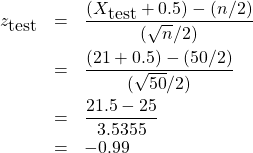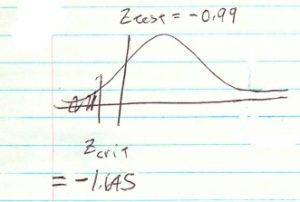16. Non-parametric Tests
16.2 Median Sign Test
The median sign test is a test of a null hypothesis about the median, MD, of a population based on the binomial distribution. To use the test, every subject is assigned a score of ![]() ,
, ![]() or
or ![]() depending on whether their data point value is greater than, the same as or less than the
depending on whether their data point value is greater than, the same as or less than the ![]() median.
median.
Since the test is based on the binomial distribution, there are two cases we need to consider. One for small samples and one for large samples where the ![]() approximation to the binomial distribution can be used.
approximation to the binomial distribution can be used.
Case 1 : small samples (![]() ). Here the test statistic is
). Here the test statistic is
![]()
and the critical statistic, ![]() comes from the Sign Test Critical Values Table for a given
comes from the Sign Test Critical Values Table for a given ![]() , 1 or 2 tailed test and a value for
, 1 or 2 tailed test and a value for ![]() where
where
![]()
Reject ![]() if
if ![]() .
.
Case 2 : large samples (![]() ). With
). With ![]() as defined for case 1, the test statistic is
as defined for case 1, the test statistic is
![]()
where
![]()
the critical statistic is ![]() obtained in the usually way using either the Standard Normal Distribution Table or (recommended) the t Distribution Table. Reject
obtained in the usually way using either the Standard Normal Distribution Table or (recommended) the t Distribution Table. Reject ![]() if
if ![]() is in the critical region.
is in the critical region.
There are 3 sets of hypotheses about the null hypothesis median, ![]() :
:
| Two-tailed | Left-tailed | Right-tailed |
Example 16.3 (Small sample size, case 1.).
Given the following snow cone sales data :
18 43 40 16 22
30 29 32 37 36
39 34 39 45 28
36 40 34 39 52
test the conjecture that the median snow cone sales is 40.
Solution.
0. Data reduction.
Reduce the data to ![]() ,
, ![]() and
and ![]() signs relative to
signs relative to ![]() :
:
![]()
![]()
![]()
![]()
![]()
![]()
![]()
![]()
![]()
![]()
![]()
![]()
![]()
![]()
![]()
![]()
![]()
![]()
![]()
![]()
so (no. of ![]() ) = 3, (no. of
) = 3, (no. of ![]() ) = 15 and
) = 15 and ![]() .
.
1. Hypothesis.
![]()
2. Critical statistic.
Using the Sign Test Critical Values Table with ![]() and
and ![]() for a two-tailed test find
for a two-tailed test find
![]()
3. Test statistic.
![]()
4. Decision.
![]()
so reject ![]() .
.
5. Interpretation.
There is enough evidence to reject the claim that the median number of snow cone sales is 40.
▢
Example 16.4 : (Large sample size, case 2.)
We wish to test the claim that the median lifetime of manufactured rubber washers is greater than or equal to 8 years. We are given the following data from a sample of 50 washers :
- 21 washers in our sample last more than 8 years
- 29 washers in our sample last less than 8 years
- (none last exactly 8 years).
Solution.
0. Data reduction.
Label the washer that last longer than 8 years with a ![]() and the others with a
and the others with a ![]() . So (no. of
. So (no. of ![]() ) = 21 and (no. of
) = 21 and (no. of ![]() ) = 29.
) = 29.
1. Hypothesis
![]() : MD
: MD ![]() 8 (claim)
8 (claim)
![]() : MD
: MD ![]() 8
8
2. Critical statistic.
Using the t Distribution Table, last ![]() line,
line, ![]() for a one-tailed test we find
for a one-tailed test we find
![]()
3. Test statistic.
![]()
so

4. Decision.

Do not reject ![]() .
.
5. Interpretation.
There is not enough evidence, at ![]() , to say that washers last less that 8 years.
, to say that washers last less that 8 years.
▢

